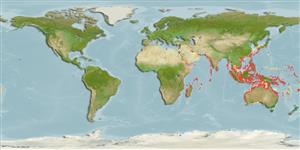Common names from other countries
Environment: milieu / climate zone / depth range / distribution range
Ecologie
Rifbewoner; diepteverspreiding 0 - 45 m (Ref. 800). Tropical
Indo-West Pacific: Red Sea to New Caledonia and Japan.
Length at first maturity / Size / Gewicht / Leeftijd
Maturity: Lm ? range ? - ? cm
Inhabits sandy and rubble areas at depths of 0 to 45 m. Feeds on algae and small invertebrates. Associated with Allopontonia iaini, Periclimenes colemani and Leutzenia asthenosomae (commensals) (Ref. 800). Its movement is assisted by non-venomous spines on the underside of its test (Ref. 85384).
Life cycle and mating behavior
Geslachtsrijpheid | Voortplanting | Kuitschieten | Eieren | Fecundity | Larven
Members of the class Echinoidea are gonochoric. Fertilization is external. Brooding is common, eggs are held either on the peristome, around the periproct or deep into the concavities on the petaloids. Life cycle: Embryos develop into planktotrophic larvae (echinoplateus) and live for several months before they sink to the bottom using their tube feet to adhere on the ground where they metamorphose into young urchins.
Schoppe, S. 2000. (Ref. 800)
Status op de Rode Lijst van het IUCN (Ref. 130435)
Status bij CITES (Ref. 108899)
Not Evaluated
Not Evaluated
Gevaarlijk voor mensen
Venomous
Gebruik door de mens
| FishSource |
Tools
Meer informatie
Leeftijd/Grootte
Groei
Lengte-gewicht parameters
Lengte-lengte parameters
Morfologie
Larven
Abundantie
Internet-bronnen
Estimates based on models
Preferred temperature
(Ref.
115969): 22.3 - 29, mean 27.8 (based on 1114 cells).
Prijsklasse
Unknown.
